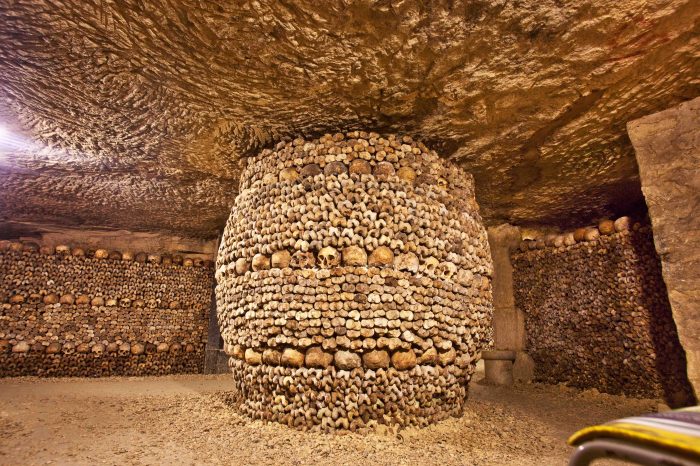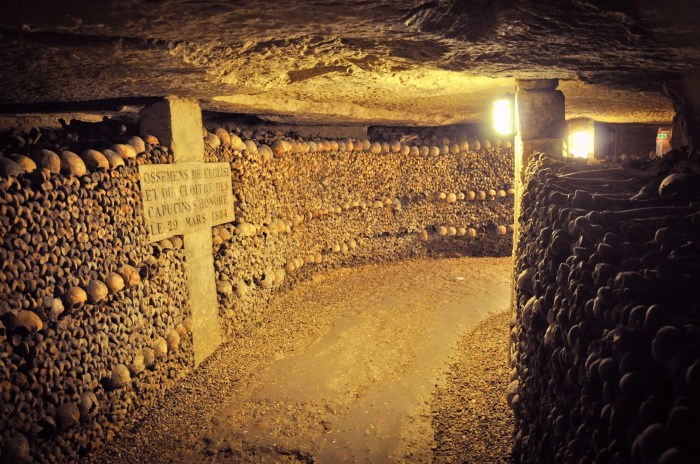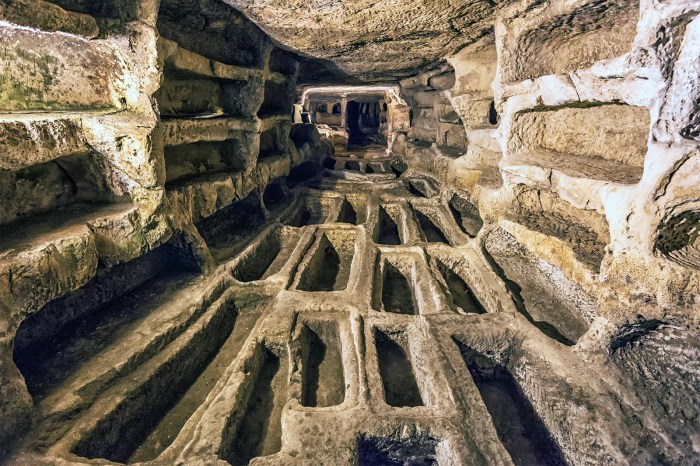Catacombs, subterranean labyrinths of history and faith, invite us on a captivating journey through time. These ancient burial sites, imbued with profound religious and cultural significance, offer a glimpse into the lives and beliefs of civilizations past.
From their humble origins as simple burial chambers to their transformation into elaborate underground cities, catacombs have played a pivotal role in shaping human history. They stand as testaments to the ingenuity, artistry, and spiritual beliefs of our ancestors.
Historical Significance

Catacombs are subterranean passageways and chambers, often associated with ancient burials. Their origins can be traced back to ancient Egypt, where they were used as burial grounds for the elite and royalty. The Romans adopted this practice and expanded the use of catacombs for communal burials, particularly for early Christian communities.
Catacombs served as important religious and social spaces for early Christians. They provided safe havens for worship and refuge during times of persecution. The walls of catacombs are often adorned with frescoes and carvings depicting biblical scenes and Christian symbols, providing valuable insights into the beliefs and practices of early Christianity.
Notable Catacombs
- Catacombs of Rome: An extensive network of underground passages and chambers, housing the tombs of countless Christians and martyrs.
- Catacombs of Paris: A vast underground cemetery containing the remains of millions of Parisians, from the Middle Ages to the 19th century.
- Catacombs of Naples: A unique collection of subterranean tunnels and chambers, adorned with intricate frescoes and sculptures depicting scenes from daily life and mythology.
Architectural Features: Catacombs

Catacombs are extensive underground burial sites characterized by their unique layout and structure. They typically consist of a network of tunnels, chambers, and niches, each serving specific purposes in the burial process.
The tunnels, often narrow and winding, provide access to the various chambers and niches. These chambers, ranging in size from small cubicles to large halls, were used for religious ceremonies, communal gatherings, and the storage of remains. Niches, carved into the walls of tunnels and chambers, served as individual burial spaces for the deceased.
In the depths of ancient history, catacombs served as subterranean burial grounds, offering a glimpse into past civilizations. In stark contrast to these underground labyrinths, the jatiluwih rice terraces stand as a testament to the beauty of nature. Verdant rice paddies cascade down the slopes, creating a mesmerizing patchwork that stretches as far as the eye can see.
Yet, amidst this serene landscape, catacombs remind us of the passage of time and the fragility of life.
Symbolism and Decorative Elements
Catacombs are not only architectural marvels but also repositories of early Christian symbolism and art. The walls of tunnels and chambers are adorned with frescoes, mosaics, and sculptures depicting biblical scenes, symbols of faith, and images of saints. These decorative elements served both as didactic tools, teaching the illiterate population about Christian beliefs, and as expressions of devotion and hope in the afterlife.
Religious and Cultural Context

Catacombs hold immense religious significance, particularly in Christianity. They served as sacred burial sites and places of worship during a period when Christians faced persecution and needed concealed spaces for their practices.
The catacombs, an ancient burial ground with winding tunnels, hold historical significance. If you’re planning a trip to explore these fascinating sites, you may need to convert currencies. For instance, converting 50000 USD to IDR (Indonesian Rupiah) will give you an approximate value of 50000 usd to idr.
Remember, exchange rates can fluctuate, so it’s wise to check the latest rates before your trip to ensure accurate budgeting for your catacomb exploration.
In the early centuries of Christianity, Roman law prohibited the burial of Christians within the city walls. Catacombs provided a solution, offering a secure and hidden refuge for the dead. They were often located outside the city limits, along major roads, and concealed within hills or underground quarries.
Burial Sites
Catacombs were primarily used as burial sites for Christian martyrs and other members of the early Christian community. Burials were often arranged in niches carved into the walls of the catacombs, known as loculi. These niches were typically sealed with marble or terracotta slabs, often inscribed with the deceased’s name and epitaph.
Places of Worship
In addition to serving as burial sites, catacombs also became places of worship and pilgrimage for early Christians. They provided a safe haven for religious gatherings and the celebration of the Eucharist. Chapels and other spaces within the catacombs were decorated with frescoes and sculptures depicting biblical scenes and Christian symbols, such as the fish and the dove.
Catacombs, subterranean passageways adorned with early Christian art, offer a glimpse into ancient beliefs and practices. Hello world! From their origins as burial sites to their transformation into places of refuge, catacombs have played a significant role in shaping our understanding of the past.
Today, they serve as captivating historical landmarks, offering visitors a unique glimpse into the lives of those who came before us.
Development of Christian Art and Iconography, Catacombs
The catacombs played a pivotal role in the development of early Christian art and iconography. The artwork found within the catacombs provides valuable insights into the beliefs, practices, and symbols of the early Christian community. Frescoes and sculptures depict scenes from the Bible, such as the miracles of Christ, the stories of the apostles, and the parables.
These images served as a means of teaching and inspiration for the Christian faithful.
Archaeological Exploration and Discoveries

Archaeological exploration and excavation of catacombs have provided valuable insights into ancient cultures and burial practices. Techniques such as ground-penetrating radar, laser scanning, and meticulous excavation methods have allowed researchers to uncover hidden chambers, intricate artwork, and artifacts.
Significant Archaeological Findings
The archaeological discoveries made in catacombs have significantly contributed to our understanding of ancient societies. For example, the catacombs of Rome have yielded a wealth of information about early Christian communities, including their beliefs, rituals, and social structures.
Major Archaeological Discoveries
- Catacombs of Priscilla:One of the oldest and most extensive catacombs in Rome, containing frescoes depicting biblical scenes and early Christian symbols.
- Catacombs of San Callisto:Home to the tomb of Pope Callixtus I and a series of underground chapels with intricate mosaics.
- Catacombs of Domitilla:Contains a well-preserved fresco of the Last Supper, providing insights into early Christian iconography.
Tourism and Preservation

Catacombs, with their rich historical significance and captivating architectural features, have become popular tourist destinations. The influx of visitors provides economic benefits to local communities but also poses challenges to the preservation of these fragile sites.
To ensure the long-term preservation of catacombs, responsible tourism practices must be implemented. These include:
- Controlled access to limit the number of visitors.
- Guided tours to educate visitors about the site’s history and importance.
- Restrictions on photography and flash photography to prevent damage to delicate surfaces.
- Implementation of conservation measures to protect the catacombs from environmental factors and vandalism.
Examples of Successful Preservation Efforts
Successful preservation efforts include:
- The Catacombs of Paris in France, where a comprehensive conservation program has been implemented, including the use of innovative techniques to stabilize and restore the catacombs’ walls and sculptures.
- The Catacombs of Rome in Italy, where strict visitor regulations and a team of dedicated conservators have helped to preserve the site’s integrity.
- The Catacombs of Syracuse in Sicily, where a combination of archaeological research and conservation efforts has led to the rediscovery and preservation of several important frescoes and inscriptions.
Sustainable Tourism Practices
Sustainable tourism practices aim to minimize the environmental impact of tourism while supporting local communities. These practices include:
- Promoting the use of public transportation or walking tours to reduce carbon emissions.
- Educating visitors about the importance of respecting the site’s environment and cultural significance.
- Encouraging local businesses to adopt sustainable practices, such as using renewable energy and reducing waste.
- Supporting local initiatives that promote the preservation and conservation of catacombs.
By implementing responsible tourism practices and promoting sustainable tourism, we can ensure that catacombs continue to serve as valuable historical and cultural resources for generations to come.
Modern Interpretations and Legacy

The evocative imagery and symbolism of catacombs continue to inspire and influence contemporary art, literature, and popular culture.Catacombs have captured the imagination of artists and writers for centuries, serving as a source of inspiration for their works. In literature, catacombs have often been depicted as places of mystery, danger, and intrigue, such as in the classic horror novel “The Catacombs” by William Hope Hodgson.
Contemporary writers continue to draw upon the imagery of catacombs to create atmospheric and suspenseful settings in their works.
In Art and Literature
In the visual arts, catacombs have been a subject of fascination for artists, inspiring works that explore themes of mortality, spirituality, and the human condition. Artists such as Anselm Kiefer and Joseph Beuys have created powerful and evocative artworks that incorporate imagery and symbolism from catacombs.
In Popular Culture
In popular culture, catacombs have also found their way into films, television shows, and video games. These depictions often play upon the mysterious and macabre associations of catacombs, using them as settings for horror stories or as places of hidden treasures and secrets.
The catacombs of Paris, in particular, have become a popular tourist destination, drawing visitors from around the world.
Enduring Fascination
The enduring fascination with catacombs can be attributed to their unique blend of historical significance, architectural intrigue, and symbolic power. They serve as a reminder of the fragility of life and the inevitability of death, while also offering a glimpse into the beliefs and practices of past civilizations.
Catacombs continue to inspire and captivate modern society, providing a rich source of material for artistic expression and cultural exploration.
Epilogue
In the tapestry of human history, catacombs hold a unique and enduring place. They serve as reminders of our mortality, the power of faith, and the enduring legacy of ancient cultures. As we continue to explore and uncover their secrets, catacombs will undoubtedly continue to captivate and inspire generations to come.
Common Queries
What is the purpose of catacombs?
Catacombs were primarily used as burial sites, particularly for early Christians who faced persecution.
What is the significance of catacombs in Christianity?
Catacombs served as important places of worship and refuge for early Christians, and they contain valuable examples of early Christian art and iconography.
How are catacombs explored and excavated?
Archaeologists use a variety of techniques, including ground-penetrating radar and laser scanning, to explore and excavate catacombs.